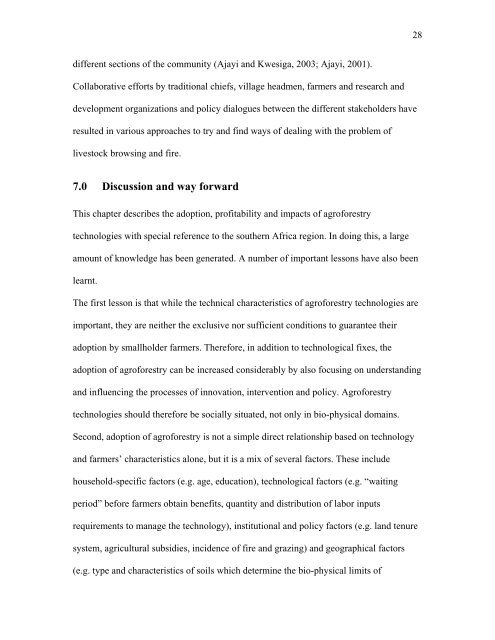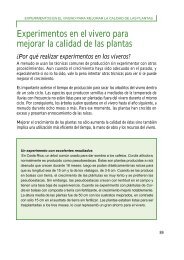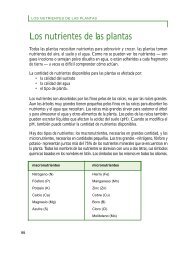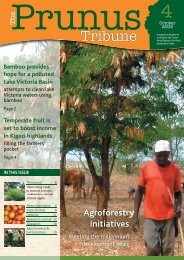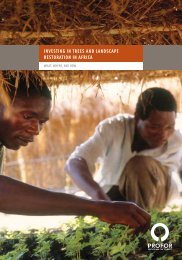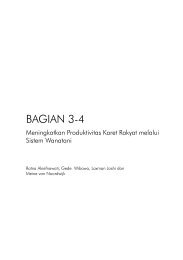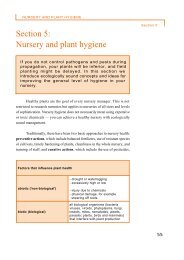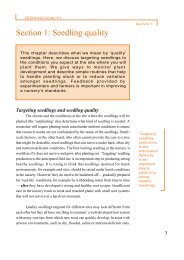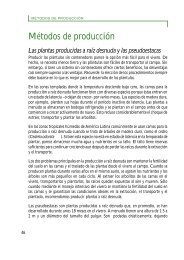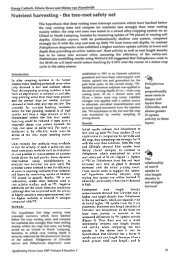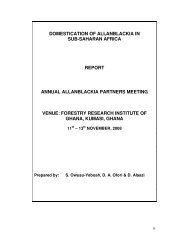1 Adoption, Profitability, Impacts and Scaling-Up of Agroforestry ...
1 Adoption, Profitability, Impacts and Scaling-Up of Agroforestry ...
1 Adoption, Profitability, Impacts and Scaling-Up of Agroforestry ...
You also want an ePaper? Increase the reach of your titles
YUMPU automatically turns print PDFs into web optimized ePapers that Google loves.
28different sections <strong>of</strong> the community (Ajayi <strong>and</strong> Kwesiga, 2003; Ajayi, 2001).Collaborative efforts by traditional chiefs, village headmen, farmers <strong>and</strong> research <strong>and</strong>development organizations <strong>and</strong> policy dialogues between the different stakeholders haveresulted in various approaches to try <strong>and</strong> find ways <strong>of</strong> dealing with the problem <strong>of</strong>livestock browsing <strong>and</strong> fire.7.0 Discussion <strong>and</strong> way forwardThis chapter describes the adoption, pr<strong>of</strong>itability <strong>and</strong> impacts <strong>of</strong> agr<strong>of</strong>orestrytechnologies with special reference to the southern Africa region. In doing this, a largeamount <strong>of</strong> knowledge has been generated. A number <strong>of</strong> important lessons have also beenlearnt.The first lesson is that while the technical characteristics <strong>of</strong> agr<strong>of</strong>orestry technologies areimportant, they are neither the exclusive nor sufficient conditions to guarantee theiradoption by smallholder farmers. Therefore, in addition to technological fixes, theadoption <strong>of</strong> agr<strong>of</strong>orestry can be increased considerably by also focusing on underst<strong>and</strong>ing<strong>and</strong> influencing the processes <strong>of</strong> innovation, intervention <strong>and</strong> policy. Agr<strong>of</strong>orestrytechnologies should therefore be socially situated, not only in bio-physical domains.Second, adoption <strong>of</strong> agr<strong>of</strong>orestry is not a simple direct relationship based on technology<strong>and</strong> farmers’ characteristics alone, but it is a mix <strong>of</strong> several factors. These includehousehold-specific factors (e.g. age, education), technological factors (e.g. “waitingperiod” before farmers obtain benefits, quantity <strong>and</strong> distribution <strong>of</strong> labor inputsrequirements to manage the technology), institutional <strong>and</strong> policy factors (e.g. l<strong>and</strong> tenuresystem, agricultural subsidies, incidence <strong>of</strong> fire <strong>and</strong> grazing) <strong>and</strong> geographical factors(e.g. type <strong>and</strong> characteristics <strong>of</strong> soils which determine the bio-physical limits <strong>of</strong>


